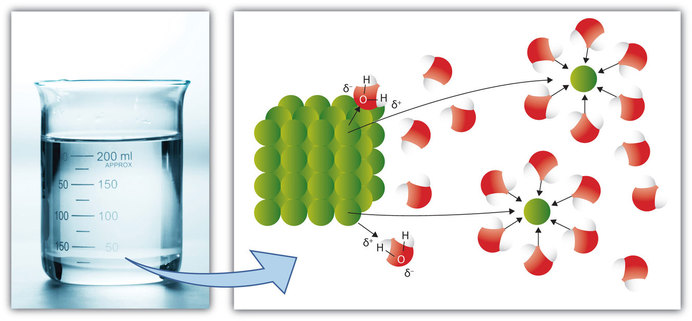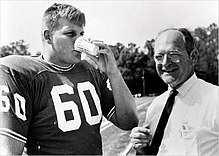9.3: The Dissolution Process
- Page ID
- 16092
- To describe the dissolution process at the molecular level
The Dissolution Process
What occurs at the molecular level to cause a solute to dissolve in a solvent? The answer depends in part on the solute, but there are some similarities common to all solutes.
Recall the rule that like dissolves like. This means that substances must have similar intermolecular forces to form solutions. When a soluble solute is introduced into a solvent, the particles of solute can interact with the particles of solvent. In the case of a solid or liquid solute, the interactions between the solute particles and the solvent particles are so strong that the individual solute particles separate from each other and, surrounded by solvent molecules, enter the solution. (Gaseous solutes already have their constituent particles separated, but the concept of being surrounded by solvent particles still applies.) This process is called solvation and is illustrated in Figure \(\PageIndex{1}\). When the solvent is water, the word hydration, rather than solvation, is used.

Ionic Compounds and Covalent Compounds as Solutes
In the case of molecular solutes like glucose, the solute particles are individual molecules. However, if the solute is ionic, the individual ions separate from each other and become surrounded by solvent particles. That is, the cations and anions of an ionic solute separate when the solute dissolves. This process is referred to as dissociation (Figure \(\PageIndex{1}\)).
The dissociation of soluble ionic compounds gives solutions of these compounds an interesting property: they conduct electricity. Because of this property, soluble ionic compounds are referred to as electrolytes. Many ionic compounds dissociate completely and are therefore called strong electrolytes. Sodium chloride is an example of a strong electrolyte. Some compounds dissolve but dissociate only partially, and solutions of such solutes may conduct electricity only weakly. These solutes are called weak electrolytes. Acetic acid (CH3COOH), the compound in vinegar, is a weak electrolyte. Solutes that dissolve into individual neutral molecules without dissociation do not impart additional electrical conductivity to their solutions and are called nonelectrolytes. Table sugar (C12H22O11) is an example of a nonelectrolyte.
The term electrolyte is used in medicine to mean any of the important ions that are dissolved in aqueous solution in the body. Important physiological electrolytes include Na+, K+, Ca2+, Mg2+, and Cl−.
The following substances all dissolve to some extent in water. Classify each as an electrolyte or a nonelectrolyte.
- potassium chloride (KCl)
- fructose (C6H12O6)
- isopropyl alcohol [CH3CH(OH)CH3]
- magnesium hydroxide [Mg(OH)2]
Solution
Each substance can be classified as an ionic solute or a nonionic solute. Ionic solutes are electrolytes, and nonionic solutes are nonelectrolytes.
- Potassium chloride is an ionic compound; therefore, when it dissolves, its ions separate, making it an electrolyte.
- Fructose is a sugar similar to glucose. (In fact, it has the same molecular formula as glucose.) Because it is a molecular compound, we expect it to be a nonelectrolyte.
- Isopropyl alcohol is an organic molecule containing the alcohol functional group. The bonding in the compound is all covalent, so when isopropyl alcohol dissolves, it separates into individual molecules but not ions. Thus, it is a nonelectrolyte
- Magnesium hydroxide is an ionic compound, so when it dissolves it dissociates. Thus, magnesium hydroxide is an electrolyte.
The following substances all dissolve to some extent in water. Classify each as an electrolyte or a nonelectrolyte.
- acetone (CH3COCH3)
- iron(III) nitrate [Fe(NO3)3]
- elemental bromine (Br2)
- sodium hydroxide (NaOH)
- Answer
-
a. nonelectrolyte
b. electrolyte
c. nonelectrolyte
d. electrolyte
Electrolytes in Body Fluids
Our body fluids are solutions of electrolytes and many other things. The combination of blood and the circulatory system is the river of life, because it coordinates all the life functions. When the heart stops pumping in a heart attack, the life ends quickly. Getting the heart restarted as soon as one can is crucial in order to maintain life.
The primary electrolytes required in the body fluid are cations (of calcium, potassium, sodium, and magnesium) and anions (of chloride, carbonates, aminoacetates, phosphates, and iodide). These are nutritionally called macrominerals.
Electrolyte balance is crucial to many body functions. Here's some extreme examples of what can happen with an imbalance of electrolytes: elevated potassium levels may result in cardiac arrhythmias; decreased extracellular potassium produces paralysis; excessive extracellular sodium causes fluid retention; and decreased plasma calcium and magnesium can produce muscle spasms of the extremities.
When a patient is dehydrated, a carefully prepared (commercially available) electrolyte solution is required to maintain health and well being. In terms of child health, oral electrolyte is given when a child is dehydrated due to diarrhea. The use of oral electrolyte maintenance solutions, which is responsible for saving millions of lives worldwide over the last 25 years, is one of the most important medical advances in protecting the health of children in the century, explains Juilus G.K. Goepp, MD, assistant director of the Pediatric Emergency Department of the Children's Center at Johns Hopkins Hospital. If a parent provides an oral electrolyte maintenance solution at the very start of the illness, dehydration can be prevented. The functionality of electrolyte solutions is related to their properties, and interest in electrolyte solutions goes far beyond chemistry.
Sports drinks are designed to rehydrate the body after excessive fluid depletion. Electrolytes in particular promote normal rehydration to prevent fatigue during physical exertion. Are they a good choice for achieving the recommended fluid intake? Are they performance and endurance enhancers like they claim? Who should drink them?
Typically, eight ounces of a sports drink provides between fifty and eighty calories and 14 to 17 grams of carbohydrate, mostly in the form of simple sugars. Sodium and potassium are the most commonly included electrolytes in sports drinks, with the levels of these in sports drinks being highly variable. The American College of Sports Medicine says a sports drink should contain 125 milligrams of sodium per 8 ounces as it is helpful in replenishing some of the sodium lost in sweat and promotes fluid uptake in the small intestine, improving hydration.
In the summer of 1965, the assistant football coach of the University of Florida Gators requested scientists affiliated with the university study why the withering heat of Florida caused so many heat-related illnesses in football players and provide a solution to increase athletic performance and recovery post-training or game. The discovery was that inadequate replenishment of fluids, carbohydrates, and electrolytes was the reason for the “wilting” of their football players. Based on their research, the scientists concocted a drink for the football players containing water, carbohydrates, and electrolytes and called it “Gatorade.” In the next football season the Gators were nine and two and won the Orange Bowl. The Gators’ success launched the sports-drink industry, which is now a multibillion-dollar industry that is still dominated by Gatorade.

Key Takeaway
- When a solute dissolves, its individual particles are surrounded by solvent molecules and are separated from each other.


